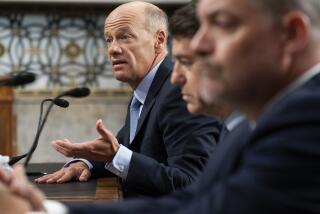Citicorp Has a Habit of Taking the Right Risks
- Share via
What’s the big lesson for business and investors in this week’s news from Citicorp that Chairman John S. Reed has committed the bank to a loss of $1 billion this year?
That the stock market, contrary to reputation, supports boldness and decisiveness more than rising quarterly earnings; that it prefers to measure in miles, not inches. After a nervous dip when Reed announced on Tuesday that Citicorp was setting aside $3 billion as a reserve against losses on loans to developing countries (causing the probable $1-billion net loss for the year), Citicorp stock has gone nowhere but up--including another $2.75 advance in Thursday’s session, when it closed at $55.875 a share.
The market, in other words, is looking beyond Reed’s wipeout of 1987 profits and applauding the nation’s largest banking company--$174 billion in assets--for dealing with the problem of loans to Latin America and developing countries elsewhere. Citicorp has more than $14 billion of such loans, including $4.6 billion in loans to Brazil on which interest is not being paid. All told, the world’s banking industry has almost $250 billion in loans to developing countries.
Spurned Easing Conditions
Those debts have been the subject of endless bank and government negotiations--and much hand-wringing--during the past five years, with easier terms for the borrowers the most frequent outcome. But Reed, who became chairman of Citicorp in September, 1984, was impatient with the idea of easier terms. He saw them helping not only the borrowers but Citi’s weaker competitors, who could avoid the earnings and capital reductions that are a consequence of recognizing loan losses.
Reed saw, moreover, that Citi could better afford to take such a hit to earnings and capital and that by not doing so it was handing its competitors a crutch. So he set aside the $3 billion, betting that the market would pressure Bank of America, Manufacturers Hanover and Chase Manhattan to do the same, weakening them competitively. And, sure enough, the stock market cheered Reed’s Darwinian tactics, dunked the competitors’ stock prices and hiked Citi’s.
It’s not the first time the market has admired Citi’s aggressiveness.
Consider that what Reed really did this week was clean up some of the mess left by his predecessor as Citicorp chairman, Walter Wriston, who was the chief advocate of lending to Latin America in the 1970s. That game got out of hand, leaving banks and borrowers in financial difficulty in this decade. But Wriston wasn’t wrong. Creating new customers in the developing countries was good business at the time, and Citi made a lot of money at it. And the Third World countries, far from being disadvantaged, got an abundance of development capital almost for the first time in history. The long-term effects of that rush of capital may be surprisingly beneficial.
Development Costly
In any event, Wriston won plaudits for Citi in the 1970s, and he also won the market’s tolerance for the huge losses Citi took in that decade on investments to computerize its operations and to expand its consumer business. The man in charge of both those efforts, costing the bank hundreds of millions of dollars in reduced earnings in the late 1970s, was John Reed, then a vice president.
Skeptics wondered why a New York-based international bank was spending so much to build a franchise in consumer loans and deposits. They wondered, too, why Wriston didn’t simply fire the oddball Reed, whose educational background was not banking but American literature and engineering. Instead, Wriston made him head of Citicorp at the age of 45.
Now their combined faith in consumer banking has paid off. It is Citi’s most profitable and important business these days, as the giant bank has expanded by acquiring savings and loan associations, making mortgage loans and issuing mortgage-backed securities--the fastest-growing area of financial services in this decade. And now the stock price, which had been held back by hesitancy over the foreign debt problem, is up.
The moral is that the market will support you if it is convinced that, as in chess, you’re thinking several moves ahead. But the market scorns playing safe, what Wriston has referred to as “a prescription for producing a dismal future: Be nice and play safe.”
He might have been referring to Bank of America, which stands today in pathetic contrast with Citi’s leadership. It’s hard to believe, but Bank of America in the 1970s was the biggest and most profitable bank in the country. Its earnings, tended to by Chairman A. W. Clausen, were considerably higher than those of Citi.
But in the 1980s it became painfully evident that B of A hadn’t built for the future. Its earnings have turned to losses; its capital has dwindled, and the once great company is reduced to selling off operations to raise cash.
The final irony: It gained virtually nothing from Clausen’s attention to reporting high profits. The price-earnings ratio of B of A stock in the late ‘70s hardly differed from that of Citicorp, which was sacrificing current earnings to build for the future.
The market admires daring, not bookkeeping.
More to Read
Inside the business of entertainment
The Wide Shot brings you news, analysis and insights on everything from streaming wars to production — and what it all means for the future.
You may occasionally receive promotional content from the Los Angeles Times.










